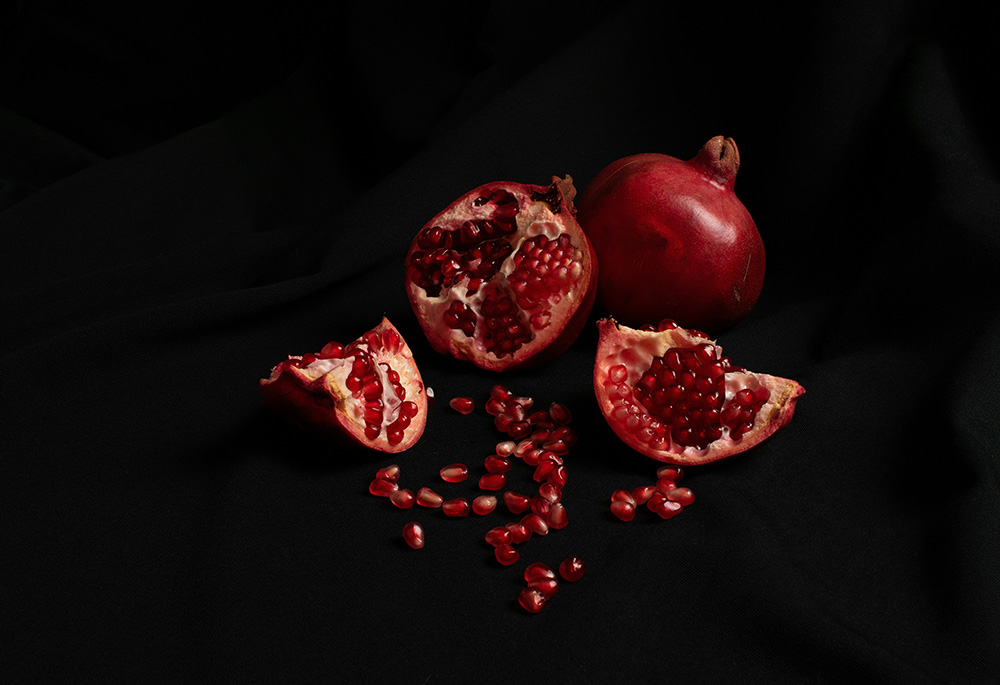
"Madonna of the Pomegranate" or "Virgin and Child with the Angels" was painted by Sandro Botticelli circa 1487 and is now housed in The Uffizi Gallery in Florence, Italy. (Wikimedia Commons/Yair Haklai, CC BY SA 4.0 deed)
Removing the peel of a pomegranate feels nothing like removing the peel of a banana or an orange. Even though I've seen plenty of video hacks that are supposed to make it easier, I've never managed to do what they say I should be able to do. It usually takes me about 30 minutes to get every little seed out of that tough red rind, but it's almost like the extra work adds to the flavor of an already delicious fruit.
I recently opened a pomegranate that had been on my kitchen counter for a while, greeting me every morning for at least a month. Based on previous experiences, I knew I was going to spend even more time and energy on this one. When I finally decided to open it one sunny afternoon, I marveled at the gem-like seeds glistening before me, newly separated from that hard, shriveled shell.
"Something's different about the pomegranate," I thought to myself.
So naturally, I went to Google to see what the internet had to say. Two things caught my attention — a piece of art and an article.
The artwork was a painting of the baby Jesus cradled on Mary's lap with a pomegranate in his hand. Called "Madonna of the Pomegranate" or "Virgin and Child with the Angels," it was painted by Sandro Botticelli circa 1487 and is now housed in the Uffizi Gallery in Florence, Italy. The museum's website describes the painting's significance: "On his mother's lap, Baby Jesus grabs the pomegranate handed to him by Mary: a fruit that was considered a symbol of Christ's passion, whose red kernels symbolize the blood shed by Jesus Christ for the salvation of humanity."
The article, "Pomegranates: Religious and Cultural Significance in the Holy Land and Catholic Church," was written by John Smith in October 2017 and it tells a similar story. Smith describes the importance of the pomegranate across a variety of cultures, customs and religions. When explaining its place in Christianity, Smith writes, "The act of opening up the rough peel and harvesting the sweet seeds has been referred to as a metaphor of the Passion of Christ, wherein the act of suffering reveals an abundant treasure from within."

(Unsplash/Margarita Zueva)
I had no idea my journey with the pomegranate would lead me to Jesus and his Passion, but I can understand the connection.
I've never endured what Jesus did, but I've endured my own types of suffering. We all have. Maybe some of us are in the midst of it right now, or we see it all around us. Maybe we've seen it in the rising levels of hunger around the globe, accompanied by violent wars, conflict and genocide. Maybe we've seen it in nature, too, in deforestation, extinction and decay.
Sometimes I want to look away, and I wonder how many people looked away as Jesus suffered on the cross. Would I have looked away?
Even in the midst of suffering that seems to never end, Jesus himself reminds us that it will end. Not only that, but there can be new, abundant life beyond the pain. In Botticelli's painting, Jesus as an infant holds up for us the promise of a forthcoming sweetness in the symbol of the pomegranate. Will we receive it? Will we not look away from the terrible challenges that we face, that the world faces? And if we choose to stay at the foot of the cross, at the feet of those who cry out, how will we journey with them to the promise of new life?
Advertisement
That's what Lent is for. A time to pause and reflect, to be in solidarity with others through prayer, fasting and giving what we can of ourselves and our resources. Lent is a time to wake up from the comfort that has lulled us to sleep.
I need Lent. I need to be reminded that comfort is not the goal. That a full life, a fulfilled life, also includes hardship; but more importantly, it includes walking with my created family through the hardship.
Lent reminds me that I am not alone, that I am part of a beautiful family of people all around the world. I am one small but significant creature among countless even tinier, yet also significant creatures. The bees count on me, and I count on them. People I will never meet need my contribution to the world, and I need theirs.
In Lent we must be honest with ourselves. Have we looked away? Will we turn back? What will we do if we turn around to find a world crying out in pain? Lent's invitation is to stay connected, to remember what matters and to give what we can. We're family. We're in this together.
I return to my beloved pomegranate, whose rough peel is also a challenge that leads to a rich reward.





